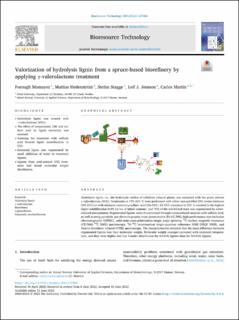Valorization of hydrolysis lignin from a spruce-based biorefinery by applying -valerolactone treatment
Peer reviewed, Journal article
Published version
Permanent lenke
https://hdl.handle.net/11250/3014703Utgivelsesdato
2022Metadata
Vis full innførselSamlinger
Sammendrag
Hydrolysis lignin, i.e., the hydrolysis residue of cellulosic ethanol plants, was extracted with the green solvent γ-valerolactone (GVL). Treatments at 170–210 ◦C were performed with either non-acidified GVL/water mixtures (NA-GVL) or with mixtures containing sulfuric acid (SA-GVL). SA-GVL treatment at 210 ◦C resulted in the highest lignin solubilization (64% (w/w) of initial content), and 76% of the solubilized mass was regenerated by water induced precipitation. Regenerated lignins were characterized through compositional analysis with sulfuric acid, as well as using pyrolysis–gas chromatography/mass spectrometry (Py-GC/MS), high-performance size-exclusion chromatography (HPSEC), solid-state cross-polarization/magic angle spinning 13C nuclear magnetic resonance (CP/MAS 13C NMR) spectroscopy, 1 H–13C heteronuclear single-quantum coherence NMR (HSQC NMR), and Fourier-transform infrared (FTIR) spectroscopy. The characterization revealed that the main difference between regenerated lignins was their molecular weight. Molecular weight averages increased with treatment temperature, and they were higher and had broader distribution for SA-GVL lignins than for NA-GVL lignins.

